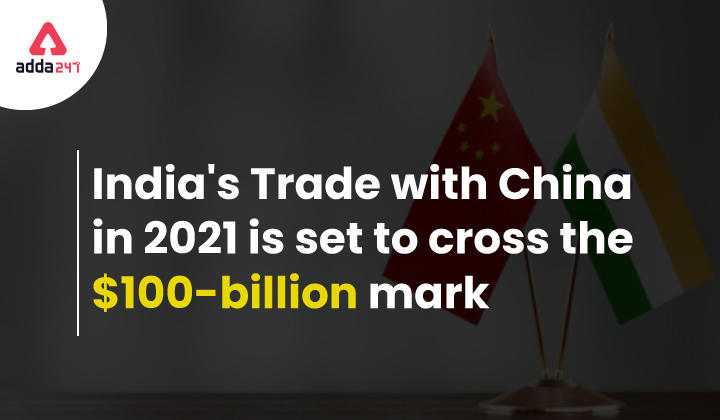G.S. Paper 2: India & Its Neighbourhood
Context:
India-China trade ties have boomed to record levels during the past year in the wake of the crisis along the Line of Actual Control which erupted last summer with China’s unprecedented mobilisation of troops.
Background:
India’s trade with China rising to record levels in 2021 and set to cross the $100-billion mark for the first time has underlined the challenge New Delhi faces as it looks to recalibrate relations amid a more than year-long border crisis while remaining locked in a deep commercial embrace.
Contradictory Trends:
- After the crisis erupted last year, India’s message to China has been that business cannot be usual while peace on the border remains disturbed.
- The business has, however, boomed, with no signs of slowing down even as the border crisis shows no signs of easing.
- Trade and investment have been providing a cushion to this otherwise tricky relationship.
- From January to September 2021, China-India bilateral trade reached $90.37 billion, up 49.3 per cent year-on-year, according to data released by China’s General Administration of Customs on October 13. China’s exports to India reached $68.46 billion, up 51.7 per cent.
India’s Economical Response after Galway Valley Standoff:
- Efforts are being made to reduce India’s dependence on Chinese goods.
- The Indian Railways, for instance, cancelled an INR 471 Crore deal with a Chinese firm.
- The massive inflow of Chinese funds into the tech sector has also been stopped.
- BSNL was instructed not to use gear from Chinese firm Huawei for a network upgrade.
- Chinese firms have been kept out of 5G trials.
- The government has mandated all products have the Country of Origin tag.
- In early July 2020, the Ministry of Power restricted power supply systems and networks import from China citing cyber and security threats.
- In July 2020 India placed colour television sets imports under the restricted category, thus requiring a licence to import; and air conditioners under the prohibited category.
- India also extended safeguard taxes on imports of solar cells and modules as well as imposed anti-dumping duty on several goods.
India’s Dependence on Chinese Goods:
- China forms an integral part of the global supply chain, and India too is heavily dependent on Chinese imports, ranging from a variety of raw materials to critical components.
- The two-way trade after nine months of Galwan Crisis reached $90.37 billion, up 49.3% year-on-year & India’s imports from China reached $68.4 billion, up 51.7%, a reminder of continuing dependencies on goods that India has imported in large quantities over the past two decades.
- At least 70 per cent of India’s active pharmaceutical ingredients are imported from China, as well as around 80 per cent of its raw silk, while 95 per cent of India’s solar power components also come from China.
- Electronic devices like mobile phones from China are also gaining significant market share, despite Indian authorities’ restrictions on Chinese firms.
Atmanirbhar Bharat Abhiyaan or Self-reliant India campaign:
- It is the vision of new India envisaged by the Hon’ble Prime Minister Shri Narendra Modi.
- On 12 May 2020, our PM raised a clarion call to the nation giving a kick start to the Atmanirbhar Bharat Abhiyaan (Self-reliant India campaign) and announced the Special economic and comprehensive package of INR 20 lakh crores – equivalent to 10% of India’s GDP – to fight COVID-19 pandemic in India.
- The aim is to make the country and its citizens independent and self-reliant in all senses.
- He further outlined five pillars of Aatma Nirbhar Bharat – Economy, Infrastructure, System, Vibrant Demography and Demand.
- Finance Minister further announces Government Reforms and Enablers across Seven Sectors under Aatmanirbhar Bharat Abhiyaan.
- The government took several bold reforms such as Supply Chain Reforms for Agriculture, Rational Tax Systems, Simple & Clear Laws, Capable Human Resource and Strong Financial System.
The potential of trade ties:
- In recent years, China has been one of India’s largest partners in merchandise and goods trade, which has consistently stood in the $90-95 billion range.
- Bilateral trade includes a very broad category of items, ranging from electronic equipment to textiles, plastic, iron and steel
- pharmaceuticals as particularly having “huge potential yet to be realised. Recently, Hyderabad-based Dr Reddy’s Laboratories became the first Indian pharmaceutical firm permitted to launch an anti-cancer drug in the lucrative China market.
- India is also looking to reduce imbalances through initiatives such as the Production Linked Incentives (PLI) scheme aimed at enhancing the resilience of India’s manufacturing sector.
Hurdles and Uncertainties:
- Border issue casting a shadow on bilateral ties.
- The border standoff affects the overall relations.
- The massive inflow of Chinese funds into the tech sector has also been stopped.
- Chinese private equity and venture capital investments fell below $1 billion for the first time since 2017.
Production Linked Incentive Scheme:
- The scheme provides incentives to Indian companies for enhancing their domestic manufacturing apart from focusing on reducing import bills and improving the cost competitiveness of local goods.
- PLI scheme offers incentives on incremental sales for products manufactured in India.
- An outlay of Rs 1.97 lakh crore for the Production-Linked Incentive (PLI) scheme for 13 identified sectors in her 2021-22 budget speech.
Conclusion:
A very long way to go to see some ground-level progress in New Delhi’s efforts to wean itself away from Beijing and become self-reliant. The PLI schemes will take at least four-five years to create fresh capacities in specific sectors. Till then reliance on China would continue. Meanwhile, the Indian side should always try to keep overall good relations with the neighbouring country.


 TSPSC Group 1 Question Paper 2024, Downl...
TSPSC Group 1 Question Paper 2024, Downl...
 TSPSC Group 1 Answer key 2024 Out, Downl...
TSPSC Group 1 Answer key 2024 Out, Downl...
 Cabinet Ministers of India 2024, New Cab...
Cabinet Ministers of India 2024, New Cab...







